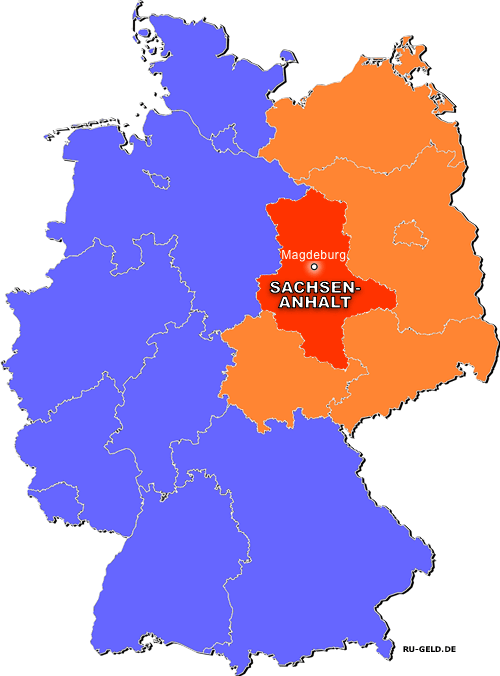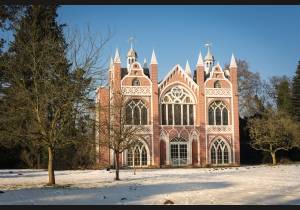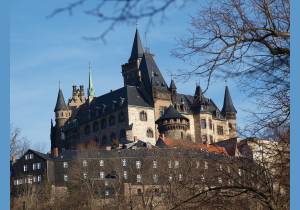German federated state of Saxony-Anhalt: characteristics, population, photos, major cities, climate, map and much more
On this page you will find interesting information, statistics about Saxony-Anhalt: major cities and the capital of the federated state, population, map, climate and weather, flag, coat of arms, photos of sightseeing attractions, ZIP code, phone codes and much more.
§ Brief overview of the Saxony-Anhalt federated state
Saxony-Anhalt is a federated state in the eastern part of Germany, which is one of the most sparsely populated states in the country. Saxony-Anhalt has beautiful nature, there are many rivers, mountains, parks, as well as ancient towns, fortresses and cathedrals there. The city of Halle (Saale) (in German: Halle) is the largest city of Saxony-Anhalt with a 1200- year-long history; here you will find the ancient castles of Giebichenstein (in German: Burg Giebichenstein) and Moritzburg (in German: Moritzburg). Other famous castles in Saxony-Anhalt are: Wernigerode (in German: Schloss Wernigerode), Merseburg (in German: Schloss Merseburg). In the northern part of the federated state there lies the Altmark region (in German: Altmark) - the least populated region in Germany.
Saxony-Anhalt has well-developed chemical industry and agriculture; tourism also plays an important role for the economy of the federated state. The scientific research centers are the university cities of Magdeburg and Halle.
§ Photos of the sightseeing attractions in the Sachsen-Anhalt federated state
To enlarge and view the picture, click on it pressing the mouse button.
-

The Wörlitzer Park of the Dessau-Wörlitz Garden Realm (in German: Dessau-Wörlitzer Gartenreich) and the Gothic House, Saxony-Anhalt
-

Wittenberg, officially Lutherstadt Wittenberg, the city of Martin Luther; Market Square
-

The City of Halle (Saale)
-

The Wernigerode Castle
-

Merseburg Schloss or the Castle of Merseburg
-

Town Hall in the Town of Wernigerode
-

The City of Magdeburg, Saxony-Anhalt
-

The Castle of Querfurt, near the City of Halle
§ Population of the Sachsen-Anhalt federated state
The population size in Saxony-Anhalt totals 2'236'252 people. Of these, 1'102'454 are men, which is 49.3 % and 1'133'798 are women or 50.7 % of the whole federated state population. The population density of the Saxony-Anhalt federated state is 109 people per 1 square kilometer.
Based on the data in Table 1 (see below on the page), the Saxony-Anhalt federated state occupies 6 % of the entire territory of Germany, which is home to 3 % of the population of the entire country, they live in 218 settlements located on the territory of the said land.
§ Climate and weather in Saxony-Anhalt
Like in other parts of the country, Saxony-Anhalt has a temperate climate with warm summers and relatively warm winters. According to the German Weather Service (aka the German Meteorological Service) (in German: DWD), in 2023 the average annual temperature in Saxony-Anhalt was 11.0 degrees Celsius, while in winter the air temperature was on average 3.1 °C, and in summer 19.0 °C. The rainfall in 2023 was 735 l/m2, and the sun shone that year in Saxony-Anhalt for 1'705 hours. Click here for more information about the Climate of Germany
§ Capital of the Saxony-Anhalt German federated state
The capital of the Saxony-Anhalt federated state is the City of Magdeburg, in German Magdeburg or Magdeburg, Landeshauptstadt, with a population of more than 240'000 people.
§ Statistics, essential data about the federated state
Table 1 below presents statistics as to the data for the federated state of Saxony-Anhalt, as well as indicators for the whole of Germany for comparison. Besides, from Table 1, you will learn the percentage ratio of the indicator for the federated state to the indicator for the whole of Germany.
Table 1. Statistical data on the Sachsen-Anhalt federated state as of early 2017.
| Descriptor | Value as to the federated state and its percentage ratio to the indicator for the whole of Germany | Value for the whole of Germany | |
|---|---|---|---|
| Name in German | Sachsen-Anhalt | - | - |
| Federated state type designation, in German | Land | - | - |
| Abbreviation (code) of the federated state, in German | ST | - | - |
| Capital of the federated state | Magdeburg (нем. Magdeburg) | - | - |
| Territory, land area | 20'452 km2 | 6 % | 357'578 km2 |
| The federated state population, all people altogether | 2'236'252 | 3 % | 82'521'653 |
| The federated state population, men | 1'102'454 | 3 % | 40'697'118 |
| The federated state population, women | 1'133'798 | 3 % | 41'824'535 |
| Population density, people per km2 | 109 | 47 % | 231 |
| Number of administrative districts (in Ger .: Bezirk) | 0 | 0 % | 19 |
| Number of counties (in Ger.: Kreis) | 14 | 3 % | 401 |
| Number of cities of regional subordinance, i.e. district-free cities or urban districts (in Ger.: kreisfreie Städte) | 3 | 3 % | 107 |
| Number of the federated state rural districts (in Ger.: Landkreis) | 11 | 4 % | 294 |
| Number of municipalities (in Ger.: Gemeinde), i.e. localities or settlements | 218 | 2 % | 11'042 |
| Number of cities | 104 | 5 % | 2060 |
§ The Saxony-Anhalt federated state holidays schedule
Every federated state in Germany has the right to establish holidays, days off from work, which are valid on their territory. On the territory of Saxony-Anhalt there are 13 official holidays. A detailed calendar of the Saxony-Anhalt federated state public holidays can be found on a dedicated page of our website. The school vacations schedule of the Saxony-Anhalt federated state is also established by a decision of the local government distinct from other German federated states.
§ Major cities in the Saxony-Anhalt federated state
In the Sachsen-Anhalt federated state there are 218 settlements, of which 104 are cities. Table 2 below contains a list of major, large cities in the said federated state.
Table 2. Major cities in the Saxony-Anhalt federated state in English and German.
| Nr. | Name of the city | Name of the city in German | Population size, rounded to thousand people |
|---|---|---|---|
| 1 | Halle | Halle (Saale) | 243'000 |
| 2 | Magdeburg (Capital of the federated state) | Magdeburg | 240'000 |
| 3 | Dessau-Roßlau | Dessau-Roßlau | 80'000 |
| 4 | Wittenberg | Wittenberg | 46'000 |
| 5 | Halberstadt | Halberstadt | 41'000 |
| 6 | Stendal | Stendal | 40'000 |
| 7 | Weißenfels | Weißenfels | 40'000 |
| 8 | Bitterfeld-Wolfen | Bitterfeld-Wolfen | 38'000 |
| 9 | Merseburg | Merseburg | 35'000 |
| 10 | Naumburg | Naumburg (Saale) | 33'000 |
| 11 | Bernburg | Bernburg (Saale) | 33'000 |
| 12 | Wernigerode | Wernigerode | 33'000 |
| 13 | Schönebeck | Schönebeck (Elbe) | 31'000 |
| 14 | Zeitz | Zeitz | 28'000 |
| 15 | Aschersleben | Aschersleben | 27'000 |
| 16 | Sangerhausen | Sangerhausen | 26'000 |
| 17 | Köthen (Anhalt) | Köthen (Anhalt) | 26'000 |
| 18 | Staßfurt | Staßfurt | 25'000 |
| 19 | Salzwedel | Salzwedel | 24'000 |
| 20 | Quedlinburg | Quedlinburg | 24'000 |
| 21 | Gardelegen | Gardelegen | 23'000 |
| 22 | Zerbst | Zerbst/Anhalt | 22'000 |
| 23 | Jessen (Elster) | Jessen (Elster) | 15'000 |
| 24 | Genthin | Genthin | 14'000 |
| 25 | Oebisfelde-Weferlingen | Oebisfelde-Weferlingen | 14'000 |
| 26 | Möckern | Möckern | 13'000 |
| 27 | Coswig, Saxony-Anhalt | Coswig (Anhalt) | 12'000 |
| 28 | Osterwieck | Osterwieck | 11'000 |
| 29 | Tangerhütte | Tangerhütte | 11'000 |
| 30 | Oberharz am Brocken | Oberharz am Brocken | 10'000 |
| 31 | Klötze | Klötze | 10'000 |
| 32 | Osterburg (Altmark) | Osterburg (Altmark) | 10'000 |
| 33 | Kemberg | Kemberg | 10'000 |
| 34 | Bismark | Bismark (Altmark) | 8'000 |
| 35 | Kalbe | Kalbe (Milde) | 8'000 |
| 36 | Arendsee | Arendsee (Altmark) | 7'000 |
| 37 | Jerichow | Jerichow | 7'000 |
| 38 | Annaburg | Annaburg | 7'000 |
§ Flag and coat of arms of the Sachsen-Anhalt federated state
In the picture below, you can see the flag or flag / coat of arms of the federated state.

§ Saxony-Anhalt on a map of Germany
In the picture below, you can see the location of the federated state and its capital on a map of Germany. Map of all the federated states of Germany and their capitals.

- Information about Germany
- All about Germany and the Germans - a general description of the country
- Administrative and territorial structure of Germany
- National symbols of Germany: flag, coat of arms, anthem, buildings, mottos and others
- Federated states of Germany and their capitals in German and English
- Political structure of Germany: parties, elections, authorities, policy
- Germany budget: structure, revenues and expenditures
- Climate and weather in Germany
- List of all German cities ordered alphabetically in English and German







